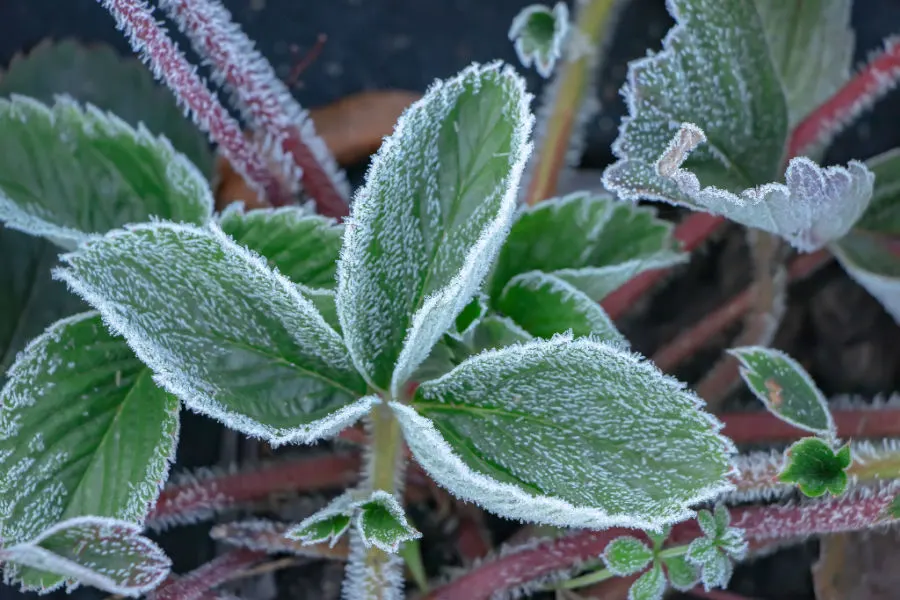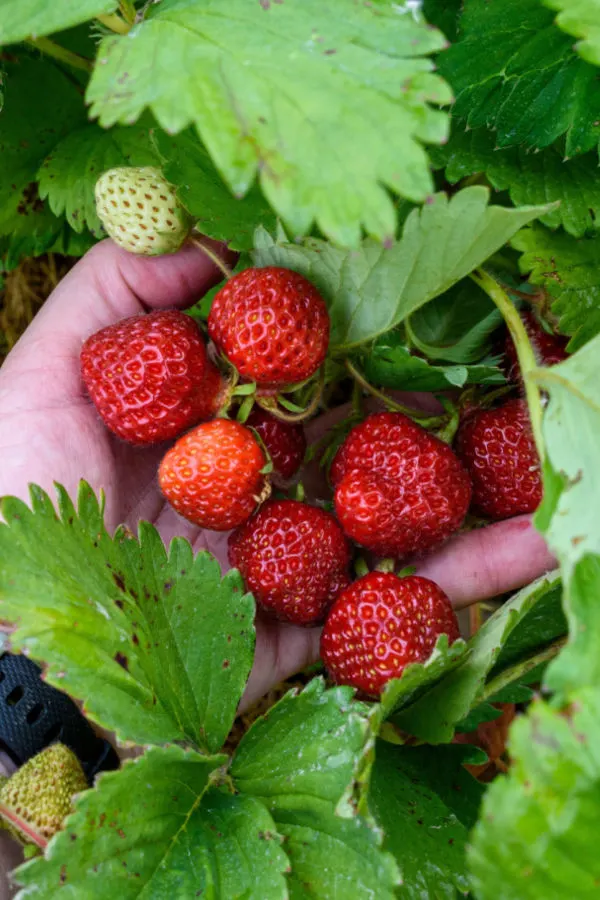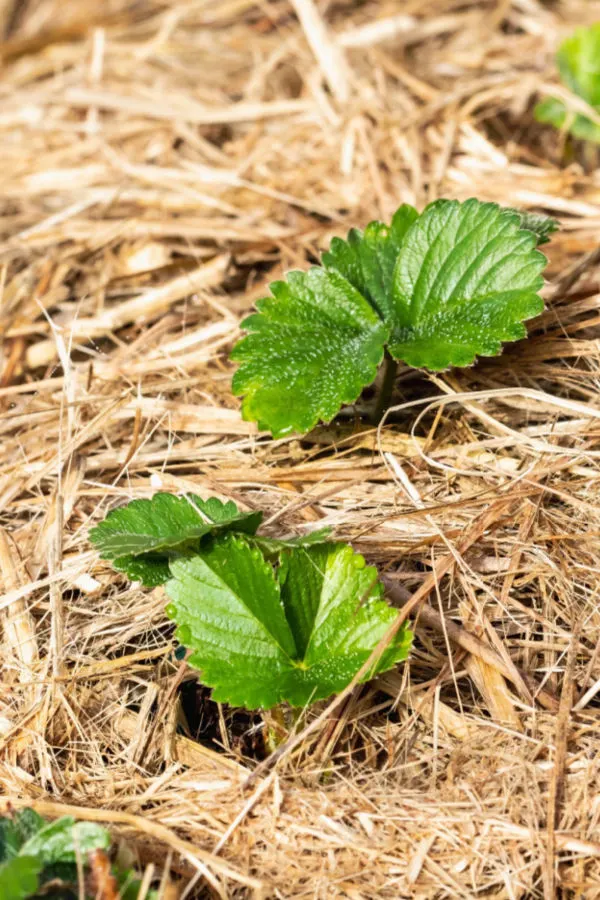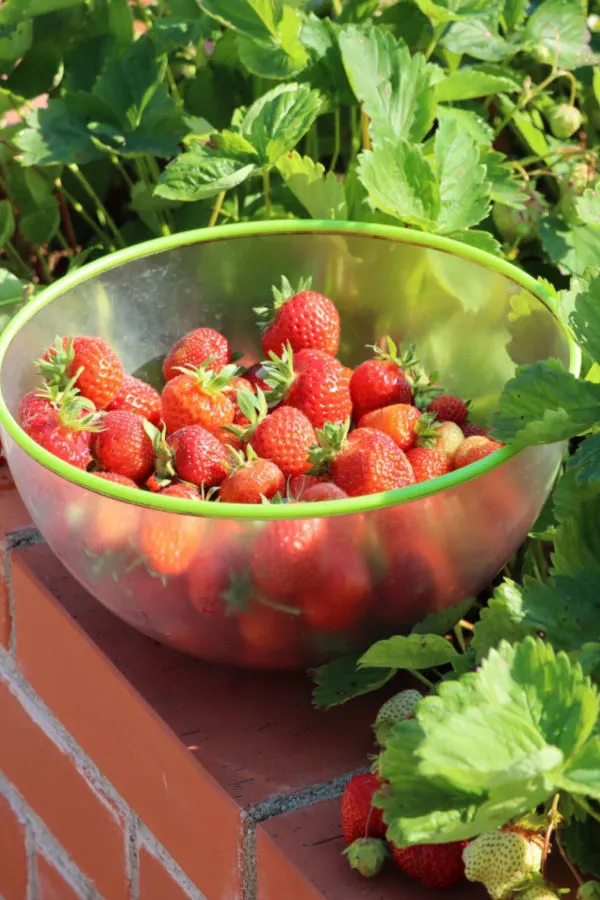Looking for the best way to protect your strawberry plants from the harsh, freezing conditions that winter can bring?
Although strawberries are a perennial plant, they certainly benefit from a little help when it comes to weathering the chill of winter. Not only to help them survive, but to set the stage for strong growth and production next spring and summer.
In fact, whether you grow your strawberries in the garden, raised beds, or in containers or hanging baskets, how you put them to bed this fall can truly spell the difference between a bumper crop next year, or plants that struggle to simply live and flower.

The good news is that protecting strawberry plants is certainly not difficult nor time consuming. Success really comes down to protecting plants based on two important factors – how and where you grow your strawberries, and what type of strawberry plants you grow.
Are your strawberries June bearing or everbearing? Do you grow them in the ground in a traditional garden setting, in raised bed, or in containers? As you will see below, your answers to these simple questions will dictate exactly how to care for your plants now – and make sure they are good to go next spring!
With that in mind, here is a in-depth look at how to properly protect your strawberry plants – no matter how, where, or what variety you grow!
How To Protect Strawberry Plants For Winter
Protecting June Bearing Strawberries
June bearing strawberries get their name from their intense production that most often occurs (depending where you live) near or around the month of June. These varieties are almost always planted in garden settings or permanent raised beds. They are rarely planted as a container plant.
June bearing varieties produce all their crop at once. Because of this, they require different care than everbearing varieties of strawberry plants. And that care is different both in the summer, and when it comes to protecting them for winter.

Once June bearing plants have completed their fruiting cycle, they should be cut and trimmed back. This usually takes place in the month of July. Again, it all depends when your June bearing plants actually bear their fruit.
Cutting back plants after they have completed fruiting helps regenerate new growth for the following year’s crop. And by doing so in mid-summer, it also allows them enough time to grow a bit of foliage for winter protection.
One of the biggest mistakes gardeners make with June bearing plants is to cut them back in the fall. Unfortunately, it often results in the crop freezing out over winter, or at the very least, sustaining heavy damage.
When cut back in the fall, they simply can’t grow enough protection back to survive the freezing and thawing of winter. If you didn’t cut back your June bearing plants this summer, whatever you do, don’t cut them back in the fall! Just allow them to overwinter with the foliage they have in place.
Fall Care For June Bearing Strawberry Plants – How To Protect Strawberry Plants For Winter
June bearing strawberry plants, even with their late season foliage growth, need to be mulched before the bitter cold of winter sets in. It not only protects the strawberry plants from freezing out, but keeps competing weeds away too. Weeds that can steal nutrients and impact production levels next year.

For mulching, straw, shredded leaves, and pine needles are all great options. Apply a few inches of mulch around and over top of the plants, Be careful not to smother them too deep. Avoid using whole leaves as they can compact and snuff the oxygen from the plants below.
Mulching should take place in late fall, as the plants go dormant and begin to lose their leaves. Avoid the temptation of fertilizing your strawberry plants in the fall. Although it may sound like a helpful idea, it actually can do more harm than good.
The new growth that could result actually puts the plants in more danger of freezing out over winter. It is simply too tender and cannot handle the harsh conditions winter brings.
How To Protect Everbearing Strawberries – How To Protect Strawberry Plants For Winter
Unlike June bearing strawberry varieties, everbearing strawberries produce their fruit all season long. They can grow anywhere – whether it be in traditional garden settings, raised beds, or even in pots and containers.
How you grow your everbearing strawberry plants will determine just how you need to protect them. For more on everbearing strawberries, be sure to see : How To Grow Everbearing Strawberries Like A Pro!
Everbearing Strawberries Growing In Beds
Because everbearing varieties produce all season long, they are never cut back. But even though they keep their foliage in-tact up until the first frost, they still need a bit of protection to get them through winter.

Just as with the June bearing plants, garden or bed planted everbearing strawberries should get a few inches of straw or shredded leaves in late fall. As the plants go into dormancy and their foliage begins to turn, it’s time to mulch!
Again, straw, pine needles or shredded leaves a few inches deep is the best option for protecting the strawberry plants. The idea is to simply provide them an extra layer of thermal protection to guard against constant freezing and thawing.
Everbearing Strawberries In Pots & Containers – How To Protect Strawberry Plants For Winter
Potted everbearing strawberry plants simply can’t protect their roots from freezing without a bit of extra insulating help. Containers will freeze and thaw constantly if left out. This constant change will usually freeze the roots of an everbearing strawberry plant out.
You really have two option when it comes to protecting potted strawberries, bringing them indoors, or digging the pots into the ground for winter.
If you have an open flowerbed or garden setting, you can dig out an area the size of the container. Then, simply “plant” the pot into the soil and apply a few inches of mulch over top. This gives them the same type of protection as strawberry plants that are in the ground.
This is actually a great way to protect any perennials that you might grow in containers each fall. See: How To Save Potted Perennials Over Winter! Protecting Potted Plants

If that is not an option, bring your plants into a garage or basement that is cool, but does not freeze. When bringing into a garage setting, always place pots against an interior heated wall to help give them a bit of extra protection. When bringing inside, there is no need to apply the additional mulch.
Here is to helping out your strawberry plants this fall – and to keeping them alive over winter! Happy Gardening – Jim and Mary.
Jim and Mary Competti have been writing gardening, DIY and recipe articles and books for over 15 years from their 46 acre Ohio farm. The two are frequent speakers on all things gardening and love to travel in their spare time.
As always, feel free to email us at thefarm@owgarden.com with comments, questions, or to simply say hello! You can sign up for our free email list in the subscribe now box in the middle of this article. Follow us on Facebook here : OWG Facebook. This article may contain affiliate links.
